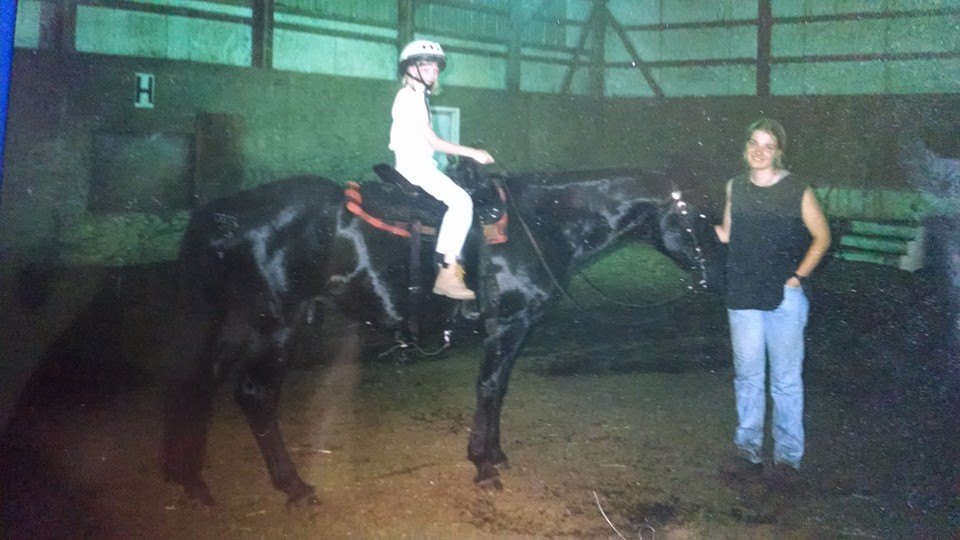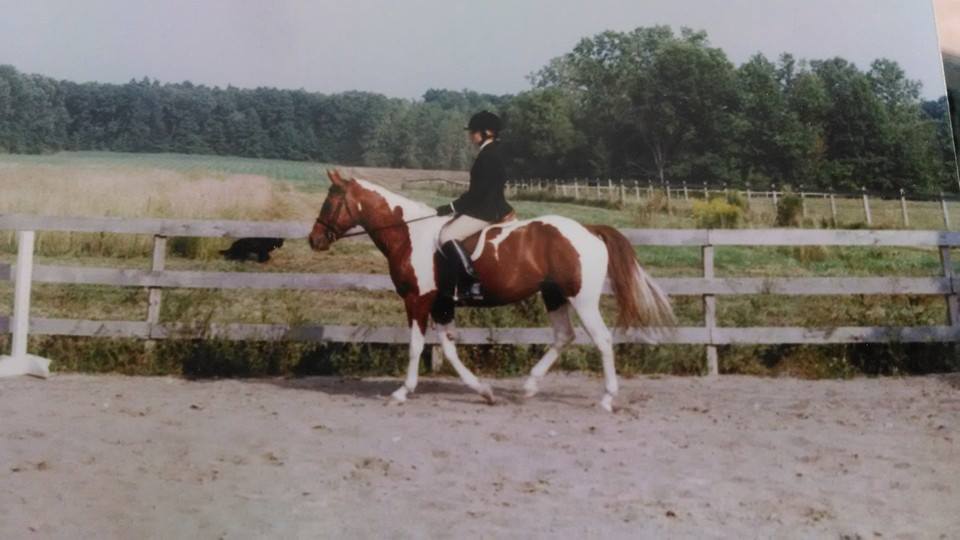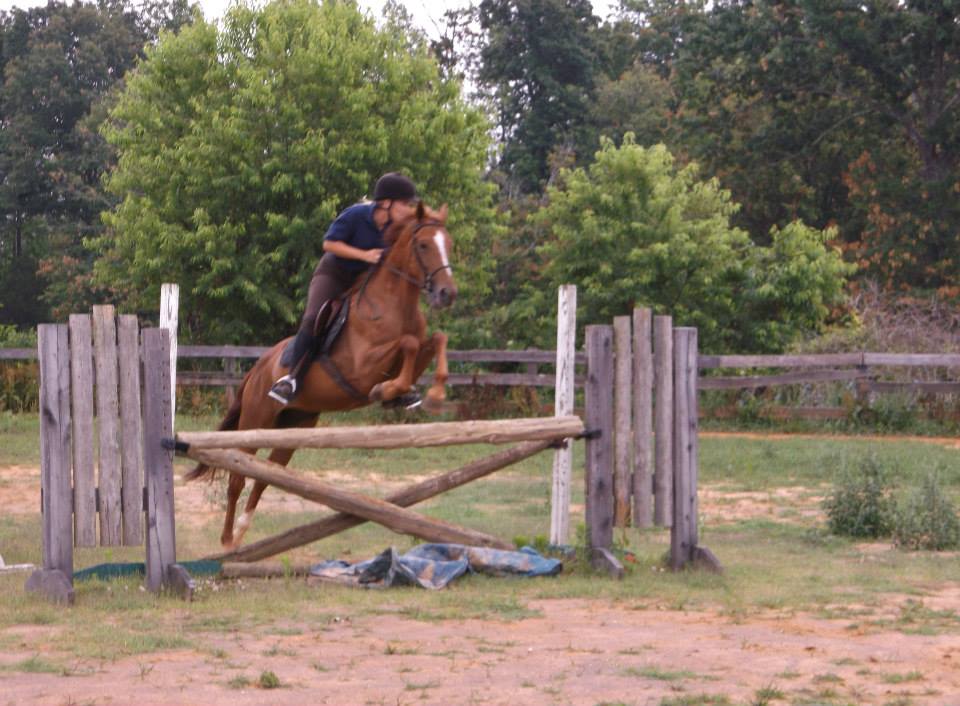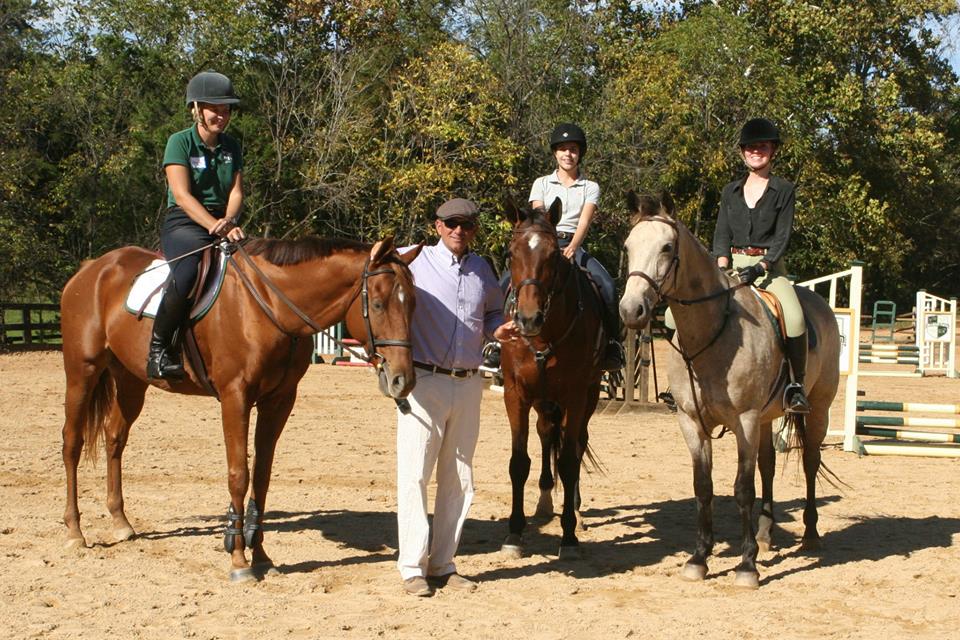About Connie




I started riding at the age of
12. Like all beginner riders in Indiana, I was started in western
lessons. But I quickly switched to english as soon as I was
allowed! Within a year I was learning to jump and loved every
minute of it! At the age of 14, I started training horses that were
brought home from the local horse auction. These varied from
Saddlebreds to Arabians to draft horses. While in high school, I
was working at various local barns. I starting teaching english and
western riding lessons.
My first big opportunity came when
being accepted to William Woods University's Equestrian Science
program (Fulton, Missouri). I spent four years riding hunters,
jumpers and equitation horses. The intense program required riding
Saddleseat, dressage and western as well. I showed "A" shows in
St.Louis and Columbia, Missouri. I took full advantage of riding in
every hunter/jumper clinic offered including ones taught by Frank
Madden and Linda Allen (1996 Olympic course designer). I showed
hunters and equitation in my first and second year of college. As a
junior and senior I started in jumpers and never looked back!During
the summer I worked in Omaha, Nebraska at a warmblood breeding
farm. I futhered my experience in starting horses by working the
farm's young warmbloods. I also learned how to start young horses
over fences and got experience taking them to their first horse
shows. I also worked as a carriage tour driver in Omaha's Old
Market district downtown.
After college, I worked in Tulsa, Oklahoma as an assistant hunter/jumper trainer and instructor. Eventually I returned to Indiana and started my own training/lesson business. For the next five years I mostly started young horses, using a combination of round pen methods and traditional english techniques designed for the individual horse's learning style.
I obtained my ARIA certification in hunt seat with a high score of 97.
Whatever your dreams and goals happen to be, I'll do whatever I can to help you achieve them. Nothing is impossible if you break down your journey into baby steps. The biggest step is taking the first one, that is just getting started! After that your success builds on the step you took before and your confidence will grow. Before you know it, you'll be where you want to be.
Our barn is now open and we are
accepting new customers. I also still offer mobile training and
lessons. Please contact me with your horse training and riding
lesson goals. Thank you!



Interview with Connie Warner:
Tips on Horse Training and Advice about the
Business
by Rachel Grant, Virginia Tech student
Connie Warner, currently based in
Charles City, Virginia, has been training for twenty years,
beginning when she bought several horses from a local auction. She
grew up in Indiana where western riding is most common. However,
Connie branched out and additionally practiced nearly every
discipline there is: jumping, dressage, cross-country jumping,
saddle seat, gaited riding, bareback riding, vaulting, driving, and
even sidesaddle. During college, she focused more on hunter/jumper
and showing. Today, she trains and teaches both hunter/jumper and
dressage.
Connie has been able to ride with some very good instructors, such
as Frank Madden and Linda Allen. Her college professor Linda
McClaren also had a big part in her development as a hunter/jumper
rider. However, she says that it is John Lyons who has had the most
influence over her training style, especially round pen work.
Author Charles DeKnuffy is an excellent dressage trainer, and his
books have aided Connie in her training. In his book Creative
Horsemanship, he teaches more than just the theory and riding
techniques behind dressage; he stresses the importance of humility,
honesty, and hard work on the part of the rider, as well.
When asked who she thought today’s “trainer’s trainer” is, Connie
replied that she loved John Lyons, Charles DeKnuffy, and George
Morris. Her favorite trainer of all time is Jimmy Williams, a
California trainer who began training western horses and then moved
to hunter/jumpers. He is very creative and often experiments with
various training techniques until he finds the right mix that works
for a particular horse. Techniques tend to fluctuate over the
years, Connie says, and it is common to “see the same techniques go
away, come back, and go away again.” The important thing is to find
a method that suits the horse you are currently working with. In
fact, this is how Connie characterizes her training methods. She
begins by working with a horse and observing him analytically, and
then she devises a training plan based on what that horse
needs.
Dressage work is important to jumpers as well as dressage horses,
Connie explains. Jumper courses are becoming more and more
technical. The horse must be strong, collected, able to lengthen or
shorten his stride, turn quickly, and be very responsive in order
to properly negotiate the course. The lateral work done in
dressage, such as leg yields and half-passes, is some of the most
important for building up strength in the hind legs. Dressage also
teaches precision and accuracy (a horse must be able to jump
straight and to take off at the right time), and builds a closer
connection between horse and rider, all of which are valuable
during jumping.
Every movement a horse is to learn in dressage (as in all other
disciplines) must be broken down into smaller steps. How small will
depend on the horse. In general, the first order of business is to
make sure the horse goes forward well. After that, he must be able
to circle correctly, and then bend to both the inside and outside
without resistance. Only after he has mastered those skills should
he be taught to leg yield, which is the most basic lateral
movement. It involves riding twenty or thirty feet off of the rail
and, using the inside leg and outside rein, asking the horse to
drift back toward the rail while still walking and facing forward.
The horse actually looks away from the direction of travel. When
the horse first starts to learn this maneuver, reward him for the
smallest of tries, even just a slight shift of his weight in the
right direction. It may only be detectable by the rider, but it
should still be acknowledged. Once the horse masters the leg yield,
the movements expand from there. Common maneuvers to follow are the
shoulder-in, shoulder-out, haunches-in, haunches-out. It is also
useful to do a lot of forward work while working on the lateral
moves. In fact, Connie explains, forward work should always be done
more than lateral work to keep the horse’s “motor” running.
Lateral work, circles, and turns all slow the horse and tend
to cut off the “motor.” Again, these movements are just as valuable
for a jumper horse to practice as a dressage horse. They build
strength and teach collection, coordination, and sensitivity.
When asked about another aspect of training, the use of
head-setting aids, Connie replied, “You can mess up a good horse
faster than anything can by using ‘head setting’ gizmos.” She
occasionally uses side reins, but only if they are needed for a
particular horse and even then they are adjusted as long as
possible on the lunge line. There are actually physical reasons why
head setting devices should generally not be used, and are outline
in the book Tug of War: Classical Versus Modern Dressage by Dr.
Gerd Heuschmann which Connie recommends. Flexing the horse’s head
too much actually causes back problems and lameness. “A horse,
properly ridden, works from back to front. Not nose in, to trailing
backend,” she states. It’s not that a horse shouldn’t be taught how
to flex at the pole, but it is important to understand why this is
desirable and how to properly go about teaching the horse to do it.
The first step is to teach him to stretch by lowering his head,
stretching out his neck, and lifting his back. Ground pole grids
work well to encourage even a stiff horse to move correctly.
Gradually, he will get stronger and learn to carry more weight on
his haunches than his front end, causing his head to flex
naturally.
According to Connie, an aspiring horse trainer should learn from as
many good trainers as they can find. The reason is that every horse
is unique, so it is beneficial to watch multiple people work with
different types of horses and use different techniques. It is also
a good idea to ride as many horses as you can. The more familiar
you are with various temperaments, styles, behaviors, etc, the more
prepared you will be to handle horses in the future. Especially
when you encounter a horse that is very similar to a horse you have
ridden in that past. Chances are you will have a good idea of how
to handle him based on your previous experience.
She would also caution aspiring trainers to make sure it is really
what they want to do. The hours are very long, customers can be
difficult, and working outside during the middle of summer and
winter weather can be harsh. If it truly is someone’s heart’s
desire to be a trainer, she recommends that one start small and
build slowly, paying only for what they need. They should avoid
debt and instead save their money, then pay cash for the items they
truly need. “Buy used, make it yourself, or go without,” Connie
suggests. She also encourages those just starting out to not be
afraid to create their own job if there are none currently
available. By listing your skill set and looking at all the things
you know how to do, it is easier to find a job than simply waiting
for someone to give you one. One should be willing to do things
like do simple tack repairs, pet sit, or braid, in addition to
trying to start training.
With the economic climate being difficult for small businesses to
thrive in, Connie shared some key factors that every trainer should
think about to keep their business afloat. Number one is to avoid
debt. If you do have debt, including debt on cars, schools, and
house mortgages, try to pay it off as quickly as possible. She
recommends two straightforward books on personal finance that will
help anyone improve their financial status: The Millionaire Next
Door by Thomas J. Stanley and William D. Danko, and Total Money
Makeover by Dave Ramsey. Most people who are wealthy have gotten to
that point based on investments they have made, what they did or
didn’t spend their money on, and their lifestyles. They didn’t
necessarily inherit their money. Connie says, “The biggest key to
becoming wealthy is being debt-free; driving used cars and living a
simple lifestyle. So when the economy goes through its down period,
you can ride out the storm. If you really have your act together,
you can stock up on investments and enjoy the gain when the economy
comes back.”
Another key is to stock pile cash when economic times are better.
During a downturn, Connie recommends offering coupons to customers
(as long as it is something you can afford to give away), or a free
lesson card. Offering incentives for your customers will increase
the chance of their continuing to come or even for a lost customer
to return. It is also helpful to get certified with the American
Riding Instructor Association (ARIA) which provides you with access
to a professional network as well as a magazine with business tips.
In short, the national economy will always fluctuate and is out of
our control. But individuals can be in charge of their own
“personal” economy if they are willing to do things like build
their own jobs if needed, offer incentives to their customers, and
exercise monetary wisdom. It is the key to one’s small business
surviving when the national economy can be so uncertain. Connie
graduated college and attempted to begin her career as a trainer
right after 9/11. The economy was in a bad recession then, but she
succeeded in spite of that. Others can, too.
That being said, the main points to be considered are to remember
that horses are unique from one another, and training methods may
have to be adjusted and adapted based on a particular horse. When
it comes to jumping, practicing dressage maneuvers will help the
horse build strength, agility, and responsiveness. The way to teach
a horse these movements, in any discipline, dressage or other, is
to break them down into small steps that the horse will understand
and to reward little tries. There are also several key things a
young aspiring horse trainer should keep in mind. One of those
things is to try to ride as many different horses and to watch as
many trainers as possible, in order to gain experience with varying
behaviors and training techniques. Another important factor is to
stay out of debt when starting a business, offer incentives to the
clients, and to not be discouraged by a downturn in the economy.
Those who are willing to be resourceful by creating their own jobs
will most likely succeed. The last important point to remember is
to make sure that being a horse trainer is something one really
wants to do. The job is rewarding, but far too demanding to only
partially want to have it as a career.
Connie has wanted to be a horse trainer since 7th grade, and there
was never a question in her mind of what type of career she wanted.
The only question was how she would get there. And now, despite
economic tough times, she has been working her dream job for two
decades and is continuing to build and expand her business. While
she wishes she could get better horses and have more work, she
knows that will come with time. When asked what the one thing she
would change about her career would be, Connie says she would not
change a single thing. It is truly her passion. “The best part is
doing what I love.”



